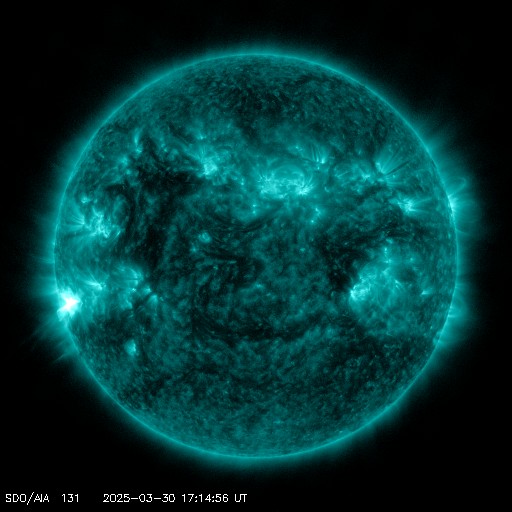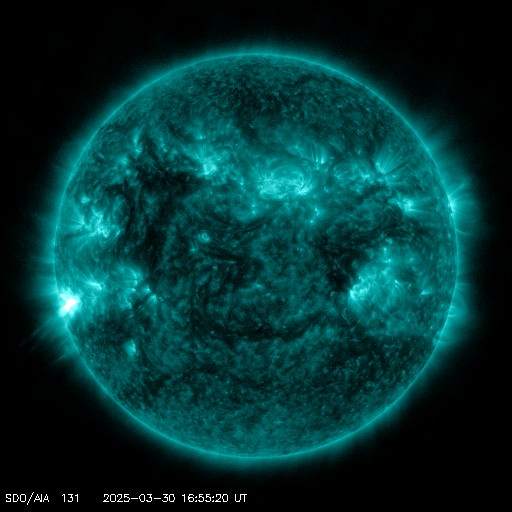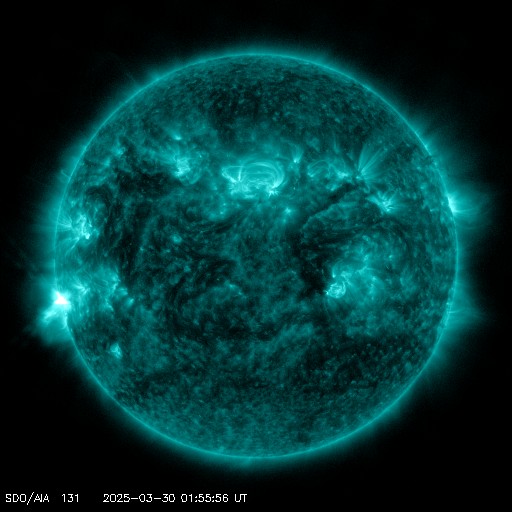Viewing archive of Saturday, 10 September 2005
Solar activity report
Any mentioned solar flare in this report has a scaling factor applied by the Space Weather Prediction Center (SWPC). Because of the SWPC scaling factor, solar flares are reported as 42% smaller than for the science quality data. The scaling factor has been removed from our archived solar flare data to reflect the true physical units.
Report of Solar-Geophysical Activity 2005 Sep 10 2204 UTCPrepared by the NOAA © SWPC and processed by SpaceWeatherLive.com
Joint USAF/NOAA Report of Solar and Geophysical Activity
SDF Number 253 Issued at 2200Z on 10 Sep 2005IA. Analysis of Solar Active Regions and Activity from 09-2100Z to 10-2100Z
Solar activity was at high levels. Region 808 (S09E44)
produced an impulsive X1 major flare at 10/1643Z with an associated
Tenflare of 600 sfu. Further significant activity included an M4/1n
at 10/1936Z, an M3/1f at 10/0614Z, and an M1 at 10/0907Z. This
region continues to exhibit an extremely complex and compact spot
group with 1400 millionths of area visible in white light. Magnetic
analysis continues to depict a very strong beta-gamma-delta
configuration in the dominant central penumbral spot. Region 809
(N10E34) was quiescent during the period. No new regions were
numbered today.
IB. Solar Activity Forecast
Solar activity is expected to be at
high levels. Region 808 is expected to continue to produce major
flares.
IIA. Geophysical Activity Summary 09-2100Z to 10-2100Z
The geomagnetic field ranged from quiet to minor storm levels.
Southward Bz and continued transient flow are responsible for the
elevated conditions. The greater than 10 MeV proton event that
began on 08/0215Z reached a peak flux of 1040 pfu at 10/1105Z. The
greater than 100 MeV proton event that began at 08/0405Z reached a
peak flux of 7 pfu at 09/1920Z.
IIB. Geophysical Activity Forecast
The geomagnetic field is
expected to be at unsettled to minor storm levels. Isolated major
storm conditions may be possible on 11 September due to the full
halo CME observed on 09 September, which was related to the X6/2b
major flare. Isolated minor storm conditions are expected to
continue on 12-13 September due to ongoing transient flow and a
recurrent coronal hole. The greater than 10 MeV proton event is
expected to continue through the next three days. The greater than
100 MeV proton event is expected to end late on 11 September.
Further major flare activity could prolong the proton events.
III. Event Probabilities 11 Sep to 13 Sep
| Class M | 90% | 90% | 90% |
| Class X | 75% | 75% | 75% |
| Proton | 99% | 99% | 99% |
| PCAF | in progress | ||
IV. Penticton 10.7 cm Flux
Observed 10 Sep 100 Predicted 11 Sep-13 Sep 100/105/105 90 Day Mean 10 Sep 091
V. Geomagnetic A Indices
Observed Afr/Ap 09 Sep 012/017 Estimated Afr/Ap 10 Sep 016/020 Predicted Afr/Ap 11 Sep-13 Sep 020/030-015/020-015/020
VI. Geomagnetic Activity Probabilities 11 Sep to 13 Sep
| A. Middle Latitudes | |||
|---|---|---|---|
| Active | 40% | 35% | 35% |
| Minor storm | 25% | 15% | 15% |
| Major-severe storm | 15% | 10% | 10% |
| B. High Latitudes | |||
|---|---|---|---|
| Active | 45% | 40% | 40% |
| Minor storm | 30% | 25% | 25% |
| Major-severe storm | 20% | 15% | 15% |
All times in UTC
Current data suggests there is a slight possibility for aurora to appear at the following high latitude regions in the near future
Norilsk, VorkutaLatest news
Latest forum messages
More topicsSupport SpaceWeatherLive.com!
A lot of people come to SpaceWeatherLive to follow the Sun's activity or if there is aurora to be seen, but with more traffic comes higher server costs. Consider a donation if you enjoy SpaceWeatherLive so we can keep the website online!

Latest alerts
17:27 UTC - Solar flare
Moderate M1.5 flare
17:03 UTC - Solar flare
Moderate M1.61 flare
16:45 UTC - Radio Blackout
Minor R1 radio blackout in progress (≥M1 - current: M1.61)
02:09 UTC - Solar flare
Moderate M1.54 flare from sunspot region 4048
01:42 UTC - Radio Blackout
Minor R1 radio blackout in progress (≥M1 - current: M1.24)
Space weather facts
| Last X-flare | 2025/03/28 | X1.1 |
| Last M-flare | 2025/03/30 | M1.4 |
| Last geomagnetic storm | 2025/03/27 | Kp5 (G1) |
| Spotless days | |
|---|---|
| Last spotless day | 2022/06/08 |
| Monthly mean Sunspot Number | |
|---|---|
| February 2025 | 154.6 +17.6 |
| March 2025 | 127.5 -27.1 |
| Last 30 days | 127.5 -24.7 |





